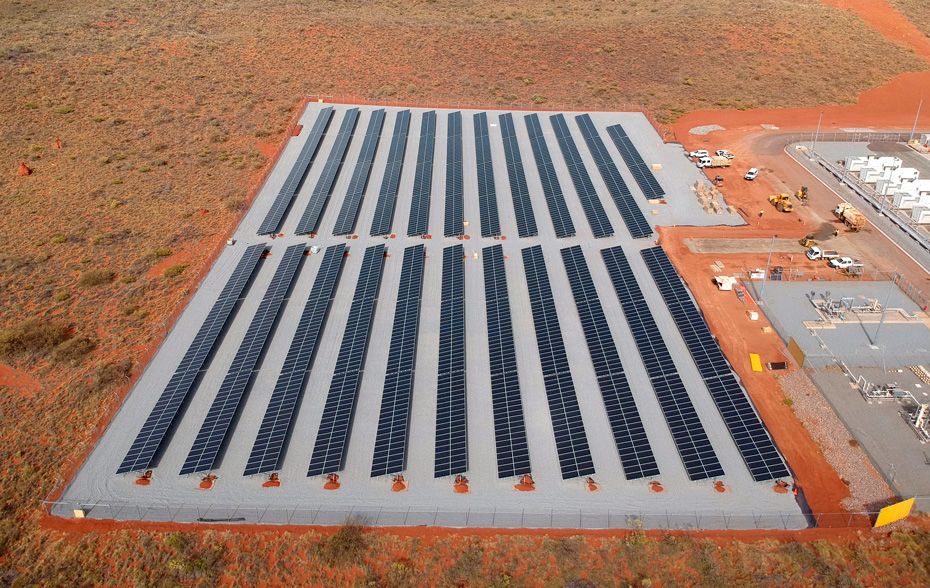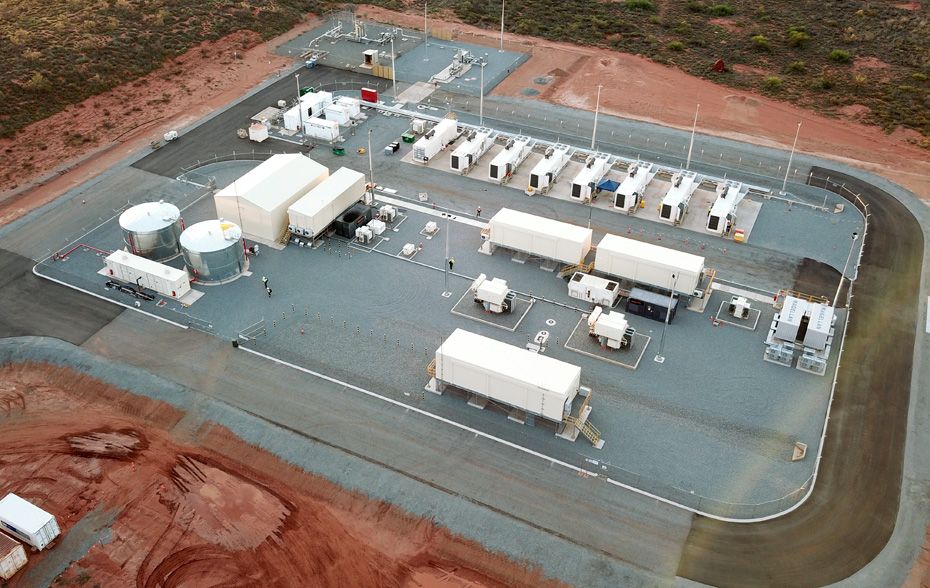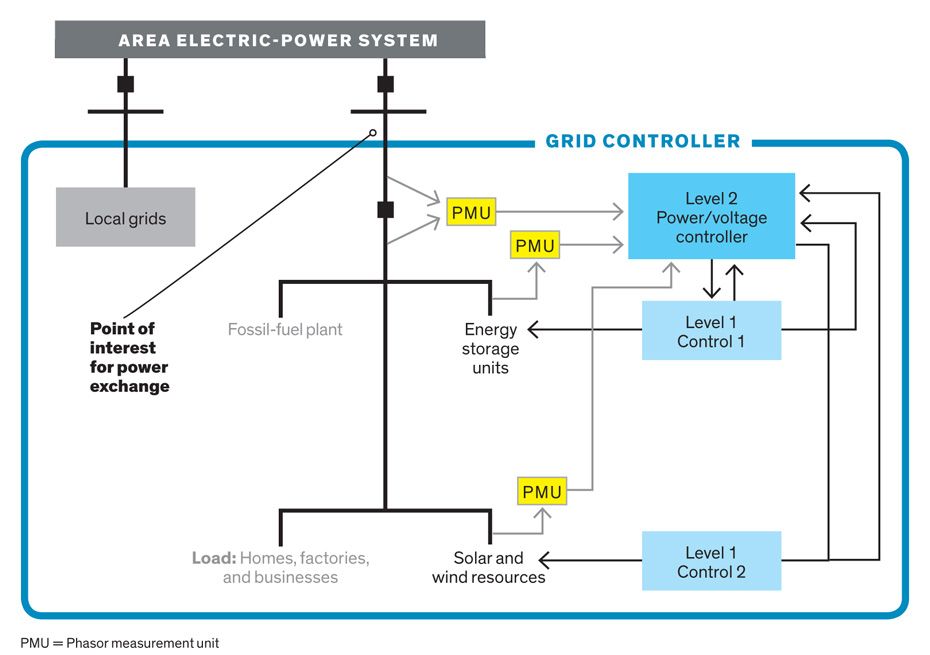The Software-Defined Power Grid Is Here


 Photos: PXISE Energy Solutions; SeongJoon Cho/Bloomberg/Getty Images Balancing Act: Electricity demand and generation near Onslow, in Western Australia, are continuously balanced thanks to a software-based microgrid controller. It monitors grid conditions at the millisecond scale, allowing efficient use of a 1-megawatt solar farm [top] and a 2.5-MW battery storage facility [middle]. A similar microgrid controller on Jeju Island in South Korea [bottom] maximizes the use of wind power, despite its intermittency.
Photos: PXISE Energy Solutions; SeongJoon Cho/Bloomberg/Getty Images Balancing Act: Electricity demand and generation near Onslow, in Western Australia, are continuously balanced thanks to a software-based microgrid controller. It monitors grid conditions at the millisecond scale, allowing efficient use of a 1-megawatt solar farm [top] and a 2.5-MW battery storage facility [middle]. A similar microgrid controller on Jeju Island in South Korea [bottom] maximizes the use of wind power, despite its intermittency. My colleagues and I have been spending a lot of time on a project in Onslow, a remote coastal town of 850 in Western Australia, where a wealth of solar, wind power, and battery storage has come on line to complement the region's traditional forms of power generation. We're making sure that all of these distributed energy resources work as a balanced and coordinated system. The team has traveled more than 15,000 kilometers from our company headquarters in San Diego, and everyone is excited to help the people of Onslow and Western Australia's electric utility Horizon Power.
Like other rural utilities around the world, Horizon faces an enormous challenge in providing reliable electricity to hundreds of small communities scattered across a wide area. Actually, calling this a wide area" is a serious understatement: Horizon's territory covers some 2.3million square kilometers-about one and a half times the size of Alaska. You can't easily traverse all that territory with high-tension power lines and substations, so local power generation is key. And as the country tries to shrink its carbon footprint, Horizon is working with its customers to decrease their reliance on nonrenewable energy. The incentives for deploying renewables such as photovoltaics and wind turbines are compelling.
But adding more solar and wind power here, as elsewhere, brings its own problems. In particular, it challenges the grid's stability and resilience. The power systems that most people are connected to were designed more than a century ago. They rely on large, centralized generation plants to deliver electricity through transmission and distribution networks that feed into cities, towns, homes, schools, factories, stores, office buildings, and more. Our 100-year-old power system wasn't intended to handle power generators that produce electricity only when the sun is shining or the wind is blowing. Such intermittency can cause the grid's voltage and frequency to fluctuate and spike dangerously when power generation isn't balanced with demand throughout the network. Traditional grids also weren't designed to handle energy flowing in two directions, with hundreds or thousands of small generators like rooftop solar panels attached to the network.
The problem is being magnified as the use of renewables grows worldwide. According to the United Nations report Global Trends in Renewable Energy Investment 2019, wind and solar power accounted for just 4 percent of generating capacity worldwide in 2010. That figure was expected to more than quadruple within a decade, to 18 percent. And that trend should continue for at least the next five years, according to the International Energy Agency. It anticipates that renewable energy capacity will rise by 50 percent through 2024, with solar photovoltaics and onshore wind making up the lion's share of that increase.
Rather than viewing this new capacity as a valuable asset, though, many grid operators fear the intermittency of renewable resources. Rather than finding a way to integrate them, they have tried to limit the amount of renewable energy that can connect to their networks, and they routinely curtail the output of these sources.
In late 2018, Horizon Power hired my company, PXiSE Energy Solutions, to better integrate renewables across its vast territory. Many electric utilities around the world are grappling with this same challenge. The chief difference between what others are doing and our approach is that we use a special sensor, called a phasor measurement unit[PDF], or PMU. This sensor, first developed in the 1980s, measures voltage and current at various points on the grid and then computes the magnitude and phase of the signals, with each digitized measurement receiving a time stamp accurate to within 1 microsecond of true time. Such measurements reveal moment-by-moment changes in the status of the network.
For many years, utilities have deployed PMUs on their transmission systems, but they haven't fully exploited the sensors' real-time data. The PXiSE team developed machine-learning algorithms so that our high-speed controller can act quickly and autonomously to changes in generation and consumption-and also predict likely future conditions on the network. This intelligent system mitigates any grid disturbances while continuously balancing solar generation, battery power, and other available energy resources, making the grid more efficient and reliable. What's more, our system can be integrated into virtually any type of power grid, regardless of its size, age, or mix of generation and loads. Here's how it works.
The basic thing a PMU measures is called a phasor. Engineering great Charles Proteus Steinmetz coined this term back in 1893 and described how to calculate it based on the phase and amplitude of an alternating-current waveform. Nearly a century later, Arun G. Phadke and his team at Virginia Tech developed the phasor measurement unit and showed that the PMU could directly measure the magnitude and phase angle of AC sine waves at specific points on the grid.

 Photos: PXISE Energy Solutions Every Watt Counts: At the headquarters of Sempra Energy in downtown San Diego, PXiSE's microgrid controller [bottom] optimizes the use of the building's electric-vehicle chargers [top], solar panels, and storage batteries. The system reduces reliance on grid power in the later afternoon and early evening, when demand and prices typically spike. Since the controller's installation in 2017, the building's utility bill has fallen about 20 percent.
Photos: PXISE Energy Solutions Every Watt Counts: At the headquarters of Sempra Energy in downtown San Diego, PXiSE's microgrid controller [bottom] optimizes the use of the building's electric-vehicle chargers [top], solar panels, and storage batteries. The system reduces reliance on grid power in the later afternoon and early evening, when demand and prices typically spike. Since the controller's installation in 2017, the building's utility bill has fallen about 20 percent. PMUs were commercialized in 1992, at which point utilities began deploying the sensors to help identify outages and other grid events." Today, there are tens of thousands of PMUs installed at major substations throughout the United States. (The accuracy of PMU data is dictated by IEEE Standard C37.118 and the newer IEEE/IEC Standard 60255-118-1-2018, which call for more accurate and consistent power measurements than are typically required for other sensors.)
But these devices are valuable for much more than simply tracking blackouts. Today's high-speed PMUs provide data 60 times per second, which is more than 200 times as fast as the sampling rate of the conventional SCADA (supervisory control and data acquisition) systems used on most electric grids. What's more, PMU data are time-stamped with great precision using the Global Positioning System (GPS), which synchronizes all measurements worldwide. For that reason, the data are sometimes called synchrophasors.
With that kind of time resolution, PMUs can provide an extremely accurate and detailed snapshot of power quality, indicating how consistently the voltage and current remain within their specified ranges. Wide fluctuations can lead to inefficiency and wasted electricity. If the fluctuations grow too large, they can damage equipment or even trigger a brownout or blackout. The time-stamped data are particularly helpful when your resources are scattered across a wide area, as in Horizon Power's grid in Western Australia.
The main reason that PMUs haven't been fully exploited is that most utilities don't take advantage of modern data communications and advanced control technologies. Even when they have PMUs and data networks in place, they haven't tied them together to help coordinate their solar, wind, and other energy resources. SCADA systems are designed to send their information every 2 or 3seconds to a central operations center where human operators are watching and can take action if something goes wrong. But the power electronics used in inverter-based systems like solar PV, wind turbines, and energy storage units operate on the millisecond level, and they require much higher-speed control to maximize their benefits.
I've spent my entire 33-year career as a power engineer working for small and large power companies in California, so I'm deeply familiar with the issues that utilities have faced as more distributed-energy resources have come on line. I long had a hunch that PMUs and synchrophasors could play a larger role in grid modernization. In 2015, when I was vice president of infrastructure and technology at Sempra Energy, I began working with Charles Wells, an expert on power system controls who was then at OSIsoft, to figure out whether that hunch was valid and what a synchrophasor-based control system might look like.
Meeting every Friday afternoon for a few hours, we spent close to a year doing calculations and running simulations that confirmed PMU data could be used to both measure and control grid conditions in real time. We then turned to Raymond de Callafon of the University of California, San Diego, and other experts at OSIsoft to figure out how to create a robust commercial system. Our goal was to build a software-based controller that would make decisions autonomously, enabling a transition away from the hands-on adjustments required by traditional SCADA systems.
The controller we envisioned would need to operate with great accuracy and at high speeds. Our system would also need artificial intelligence to be able to forecast grid conditions hourly and daily. Because our platform would be largely software based, it would require a minimum of new hardware, and the integration into an existing network would be quick and inexpensive. In essence, we sought to create a new operating system for the grid.
By early 2017, our system was ready for its first real-world test, which took our team of six engineers to a 21-MW wind farm and battery storage facility on an island in Hawaii. In recent years, Hawaii has dramatically increased solar and wind generation, but this particular island's grid had reached a limit to integrating more renewable energy, due to the variability of the wind resources. It was less complicated for the grid operator to rely on fossil-fueled generators than to mitigate the intermittent power from the wind farm, which was periodically shut off, or curtailed, at night to ensure grid stability.
We were on a startup's budget, so we used off-the-shelf equipment, including a standard PC running a digital simulator model that de Callafon created. We rented a house near the wind farm, where we spent several days testing the technology. It was a fantastic moment when we realized we could, in fact, control energy generation at the wind farm from the kitchen table. (We took all due cybersecurity precautions, of course.) With our control system in place, the inherent power fluctuations of the wind farm were smoothed out by real-time dispatch from the battery storage facility. This allowed the wind farm's generation to be far more reliable.
A Power Grid OS Image: PXISE Energy Solutions Like an operating system for a computer, PXiSE's software-based controller manages the network's resources. In the microgrid above, solar and wind power, energy storage, and a fossil-fuel power plant supply electricity to homes, factories, and businesses. Using data from phasor measurement units (PMUs), the controller continuously balances generation and load within the microgrid and keeps the microgrid's connection to the main grid stable.
Image: PXISE Energy Solutions Like an operating system for a computer, PXiSE's software-based controller manages the network's resources. In the microgrid above, solar and wind power, energy storage, and a fossil-fuel power plant supply electricity to homes, factories, and businesses. Using data from phasor measurement units (PMUs), the controller continuously balances generation and load within the microgrid and keeps the microgrid's connection to the main grid stable. Soon after completing the Hawaii project, we installed a controller running our PMU-based algorithm to create a microgrid in Sempra Energy's high-rise office building in downtown San Diego. The controller was designed to optimize the use of the building's electric-vehicle chargers, solar panels, and storage batteries. Meanwhile, it would also reduce the reliance on grid power in the late afternoon and early evening, when demand and prices typically spike. At such times, the optimization algorithm automatically determines the proper resource mix and schedule, enabling one floor to be served solely by local renewable sources and stored energy rather than the main grid. This shift reduced the building's utility bill by 20 percent, which we've since found to be typical for similar microgrids.
More recently, our team traveled to Jeju Island, in South Korea. Prior to the installation of our grid controller, the island's electricity primarily came from the mainland via high-voltage underwater cables. The system was designed to interconnect two local battery-storage systems-with capacities of 224 kilowatt-hours and 776 kWh-with a 500-kW solar farm and 600 kW of wind power. To meet the island's renewable energy goals and save on electricity costs, wind and solar power are stored in the batteries during the day, when power demand and grid prices are low. The stored electricity is then used at night, when power demand and grid prices are high.
The on-site installation of our controller took just four days. In addition to operating the two battery-storage systems throughout the day and night, PXiSE's controller uses the batteries to provide what's known as ramp control" for the wind turbines. Most grids can tolerate only a gradual change in power flow, typically no more than 1 megawatt per minute, so ramp control acts like a shock absorber. It smooths out the turbines' power output when the wind suddenly changes, which would otherwise cause reliability problems on the grid.
Every 16.7 milliseconds (one cycle of the 60-hertz wave), the controller looks for any change in wind power output. If the wind stops blowing, the system instantly compensates by discharging the batteries to the grid, gradually decreasing the amount of discharged battery power to zero, as power from the main grid gradually increases to match demand. When the wind starts blowing again, the batteries immediately respond by absorbing a portion of the generated wind power, gradually reducing the amount being stored to zero as the controller ramps up the amount feeding into the grid, thereby meeting real-time energy demand.
The control system also creates its own forecasts of load and generation based on weather forecasts and AI processing of historical load data. The forecasting models are updated in real time to compute the optimal settings for power and energy storage in the system.
At each of our other projects-in Chile, Guam, Hong Kong, Japan, Mexico, and a handful of U.S. sites-the system we provide looks a little different, depending on the customer's mix of energy resources and what their priorities are. We designed the PXiSE system so it can be deployed in any part of the electric grid, from a rooftop solar array all the way to a centralized power plant connected to a large network. Our customers appreciate that they don't have to install additional complex equipment beyond the controller, that integrating our technology is fast, and that they see positive results right away.
The work we're doing is just one part of a far bigger goal: to make the grid smarter and cleaner. This is the great challenge of our time. The power industry isn't known for being on the cutting edge of technology adoption, but the transition away from a century-old, hardware-dependent analog grid toward a modern software-based digital grid is not just desirable but essential. Our team of enthusiastic entrepreneurs and engineers joins thousands of others around the world who are committed to making a difference in the future of our industry and our planet.
This article appears in the July 2020 print issue as The Software-Defined Power Grid."
About the AuthorPatrick T. Lee is CEO of PXiSE Energy Solutions and vice president of infrastructure and technology at Sempra Energy, in San Diego.